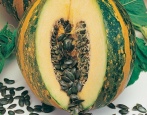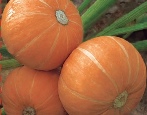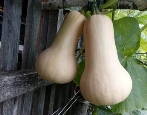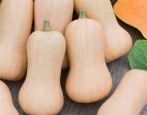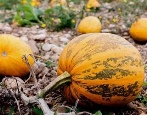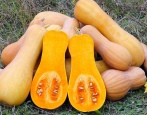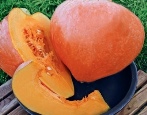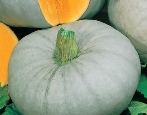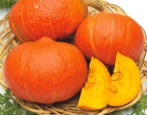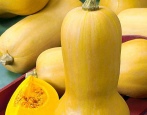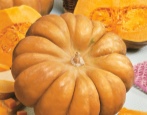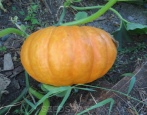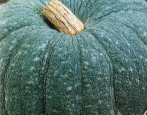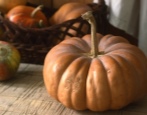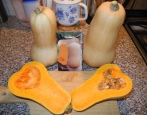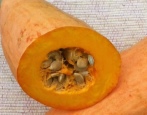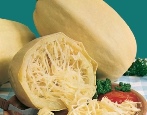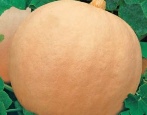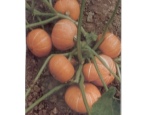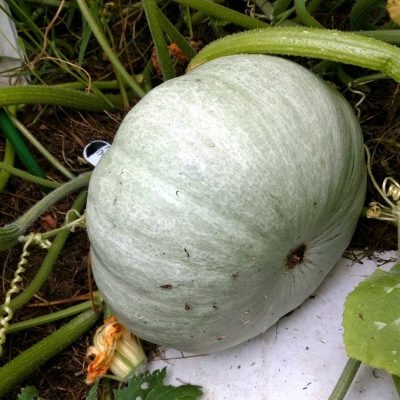
- Year of approval: 1972
- The form: spherical, flattened
- Weight, kg: 3-4
- Coloration: gray without pattern
- Bark: thin
- Color of the pulp: bright yellow or reddish yellow
- Pulp thickness, cm: 3-5
- Pulp (consistency): dense, juicy, tender, chipping
- Taste: sweet
- Taste qualities: excellent
Pumpkin is a healthy vegetable that can be used to prepare many different dishes, from soups to sweet pies. It is easy even for a beginner to grow it, if you choose the right variety that adapts to the climatic features of the growing zone. For the Middle Volga region, the pumpkin variety Gribovskaya winter is suitable.
Breeding history
Gribovskaya winter pumpkin is a variety with a long history, created by scientists on the basis of the Federal Research Center of Vegetable Growing in 1964. After numerous variety trials, the vegetable crop in 1972 joined the ranks of the State Register of Breeding Achievements of the Russian Federation. The vegetable is maximally productive, growing in the Middle Volga region. In addition, farmers in Ukraine and Moldova like to grow pumpkin.
Description of the variety
The proven pumpkin variety is a robust plant that creeps smoothly along the ground. It is characterized by moderate thickening of large-lobed dark green leaves, consisting of five petals, long lashes, growing more than 2 meters, on which there are numerous antennae, strong stems and a fragile root system. During the flowering period, large yellow-orange unisexual flowers are formed on the bushes, located alone. On one healthy plant, from 4 to 6 fruits are formed.
Characteristics of the appearance of plants and fruits
Pumpkin Gribovskaya winter is a vegetable with an attractive presentation, which belongs to the category of medium-fruited species. Vegetables weighing 3-4 kg are ripened, sometimes larger specimens are found - about 7 kg. The shape of the pumpkin is spherical, with flattened sides. The peel of vegetables is thin, but strong, uniformly colored in a gray-green color without a noticeable pattern. The surface is smooth, but sometimes there are specimens with noticeable ribs. The content of flat seeds in the pumpkin pulp is small.
Cut vegetables are easy to transport and also have good keeping quality. It is characteristic that the longer the pumpkin is stored, the tastier and more aromatic it becomes.
Purpose and taste
The variety is famous for its excellent taste. The bright yellow or yellow-reddish pulp has a fleshy, tender, dense, chipping and very juicy consistency. The thickness of the pulp is 3-5 cm. The taste is balanced - pronounced sweetness, light sugar content, complemented by a bright pumpkin aroma. The pulp contains about 10% sugars, carotene, many useful vitamins and minerals.
The harvested crop is widely used in cooking - pumpkin is added to the first and second courses, juices, preserves are made, and the filling for baking is prepared from it. In addition, the variety is suitable for baby and dietetic food.
Ripening terms
Gribovskaya winter is a late-ripening variety. The growing season lasts 130-145 days. Vegetables ripen gradually, so it is recommended to cut the ripened specimens in a timely manner, making it possible to ripen the rest of the fruits. The dried stalk and uniform color of the bark testify to the full ripeness of vegetables. Harvested usually in August-September.
Yield
The variety is very productive if you provide the culture with basic agricultural techniques.On average, one plant per season produces 10-12 kg of juicy vegetables. Growing a crop for commercial purposes, from 1 hectare of plantations, an average of about 60 tons of juicy and useful fruits can be obtained.
Growing and care
You can grow a pumpkin by seed or seedling. Sowing seeds for seedlings is carried out in April. For this, peat or disposable cups are prepared, a nutritious substrate and high-quality seed. The seeds are deepened by 3-6 cm. The germination of non-germinated seeds occurs on the 5-7th day. Growing bushes takes 25-30 days. For transplantation, mature bushes with 3-5 leaves are suitable. Saplings are planted in a permanent place from late May to early June. Landing can be done in several ways - wide-row (scheme 150x100 cm) or square-nested (100x100 cm).
When cultivating a vegetable through direct sowing in open ground, it is necessary to select the seeds and prepare the holes. The seeds are buried in the soil by 5-6 cm. Sowing is carried out according to the scheme 60x60 cm. The seeds are sown during the period when the soil and air are well warmed up. As a rule, this is the end of May - beginning of June.
Cultural agrotechnology consists of a number of procedures - watering with warm water every week (3-5 liters of water per plant), loosening and weeding the soil, forming a bush (pinching the central whip at a length of 120-150 cm), applying fertilizers twice a season (after emergence of seedlings and during flowering), prevention of fungal infections.
Requirements for soil and climatic conditions
The pumpkin is resistant to adverse weather conditions. For planting, beds are selected in the southern part of the garden, where there is a lot of sun and light, and also protected from drafts. It is comfortable to grow a vegetable in light, fluffy, fertile soils with good moisture and air permeability with neutral acidity.
Disease and pest resistance
The culture has an average immunity - pumpkin is tolerant to fruit rot and bacteriosis, as well as resistant to powdery mildew and anthracnose. Sometimes plantings are attacked by spider mites, slugs and melon aphids.
